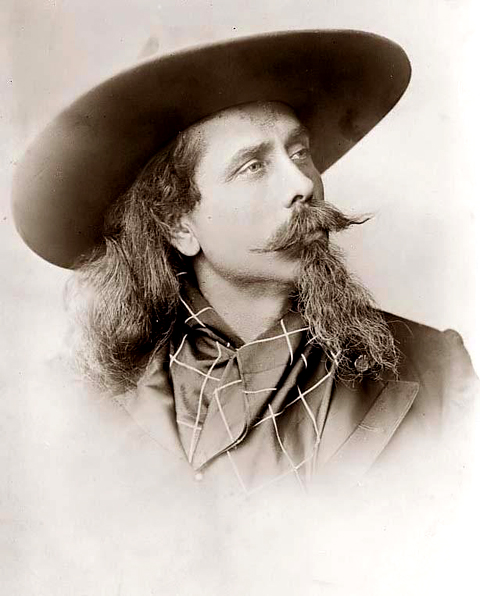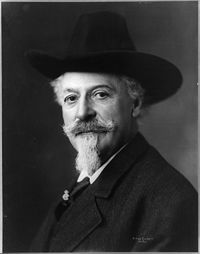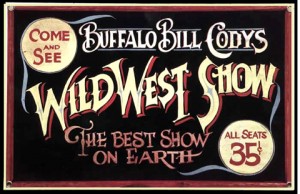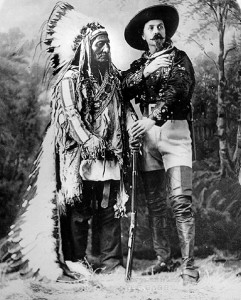
(NOTE: in 2014 I received a note from David Hakim letting me know that the above picture is actually Samuel Franklin Cody, not Buffalo Bill. He encouraged the public to confuse him with Buffalo Bill)
From Wikipedia:
“William Frederick “Buffalo Bill” Cody (February 26, 1846 – January 10, 1917) was an American soldier, bison hunter and showman. He was born in the Iowa Territory (now the American state of Iowa), near Le Claire. He was one of the most colorful figures of the American Old West, and mostly famous for the shows he organized with cowboy themes.
“William Frederick Cody (“Buffalo Bill”) got his nickname after he undertook a contract to supply Kansas Pacific Railroad workers with buffalo meat. Cody earned the nickname by killing 4,860 American Bison (commonly known as buffalo) in eight months (1867–68).
 “In addition to his documented service as a soldier during the Civil War and as Chief of Scouts for the Third Cavalry during the Plains Wars, Cody claimed to have worked many jobs, including as a trapper, bullwhacker, “Fifty-Niner” in Colorado, a Pony Express rider in 1860, wagonmaster, stagecoach driver, and even a hotel manager, but it’s unclear which claims were factual and which were fabricated for purposes of publicity.
“In addition to his documented service as a soldier during the Civil War and as Chief of Scouts for the Third Cavalry during the Plains Wars, Cody claimed to have worked many jobs, including as a trapper, bullwhacker, “Fifty-Niner” in Colorado, a Pony Express rider in 1860, wagonmaster, stagecoach driver, and even a hotel manager, but it’s unclear which claims were factual and which were fabricated for purposes of publicity.
“In December 1872 Cody traveled to Chicago to make his stage debut with friend Texas Jack Omohundro in The Scouts of the Prairie, one of the original Wild West shows produced by Ned Buntline.[8] During the 1873-74 season, Cody and Omohundro invited their friend James Butler “Wild Bill” Hickok to join them in a new play called Scouts of the Plains.
“The troupe toured for ten years and his part typically included an 1876 incident at the Warbonnet Creek where he claimed to have scalped a Cheyenne warrior, purportedly in revenge for the death of George Armstrong Custer.
“It was the age of great showmen and traveling entertainers. Cody put together a new traveling show based on both of those forms of entertainment. In 1883 in the area of North Platte, Nebraska he founded “Buffalo Bill’s Wild West,” (despite popular misconception, the word “show” was not a part of the title) a circus-like attraction that toured annually
 “In 1893 the title was changed to “Buffalo Bill’s Wild West and Congress of Rough Riders of the World”. The show began with a parade on horseback, with participants from horse-culture groups that included US and other military, American Indians, and performers from all over the world in their best attire. There were Turks, Gauchos, Arabs, Mongols and Georgians, among others, each showing their own distinctive horses and colorful costumes. Visitors to this spectacle could see main events, feats of skill, staged races, and sideshows. Many authentic western personalities were part of the show. For example Sitting Bull and a band of twenty braves appeared. Cody’s headline performers were well known in their own right. People like Annie Oakley and her husband Frank Butler put on shooting exhibitions along with the likes of Gabriel Dumont. Buffalo Bill and his performers would re-enact the riding of the Pony Express, Indian attacks on wagon trains, and stagecoach robberies. The show typically ended with a melodramatic re-enactment of Custer’s Last Stand in which Cody himself portrayed General Custer.
“In 1893 the title was changed to “Buffalo Bill’s Wild West and Congress of Rough Riders of the World”. The show began with a parade on horseback, with participants from horse-culture groups that included US and other military, American Indians, and performers from all over the world in their best attire. There were Turks, Gauchos, Arabs, Mongols and Georgians, among others, each showing their own distinctive horses and colorful costumes. Visitors to this spectacle could see main events, feats of skill, staged races, and sideshows. Many authentic western personalities were part of the show. For example Sitting Bull and a band of twenty braves appeared. Cody’s headline performers were well known in their own right. People like Annie Oakley and her husband Frank Butler put on shooting exhibitions along with the likes of Gabriel Dumont. Buffalo Bill and his performers would re-enact the riding of the Pony Express, Indian attacks on wagon trains, and stagecoach robberies. The show typically ended with a melodramatic re-enactment of Custer’s Last Stand in which Cody himself portrayed General Custer.
“Despite all of the recognition and appreciation Cody’s show brought for the Western and American Indian cultures, Buffalo Bill saw the American West change dramatically during his tumultuous life. Bison herds, which had once numbered in the millions, were now threatened with extinction. Railroads crossed the plains, barbed wire, and other types of fences divided the land for farmers and ranchers, and the once-threatening Indian tribes were now almost completely confined to reservations. Wyoming’s resources of coal, oil and natural gas were beginning to be exploited towards the end of his life.
“In contrast to his image and stereotype as a rough-hewn outdoorsman, Buffalo Bill pushed for the rights of American Indians and women. “What we want to do is give women even more liberty than they have. Let them do any kind of work they see fit, and if they do it as well as men, give them the same pay.
 “Having been a frontier scout who respected the natives, he was a staunch supporter of their rights. He employed many more natives than just Sitting Bull, feeling his show offered them a better life, calling them “the former foe, present friend, the American”, and once said, “Every Indian outbreak that I have ever known has resulted from broken promises and broken treaties by the government”.
“Having been a frontier scout who respected the natives, he was a staunch supporter of their rights. He employed many more natives than just Sitting Bull, feeling his show offered them a better life, calling them “the former foe, present friend, the American”, and once said, “Every Indian outbreak that I have ever known has resulted from broken promises and broken treaties by the government”.
“In his shows the Indians were usually the “bad guys”, attacking stagecoaches and wagon trains in order to be driven off by “heroic” cowboys and soldiers. Bill also had the wives and children of his Indian performers set up camp – as they would in the homelands – as part of the show, so that the paying public could see the human side of the “fierce warriors”; that they were families like any other, just part of a different culture.”
“In addition, despite his history of killing bison, he supported conservation by speaking out against hide-hunting and pushing for a hunting season.”
William F. Cody died of kidney failure on January 10, 1917.
You can get more information at the Buffalo Bill Historical Center website by clicking HERE.
If you have problems seeing the video below click HERE
.youtube::Fuh2bn0chw0::
